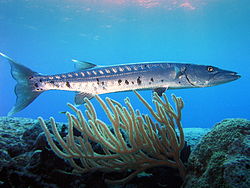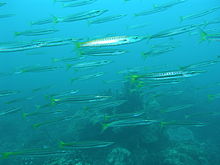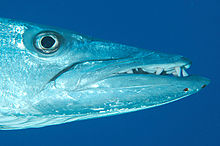
Barracuda
Background to the schools Wikipedia
This selection is made for schools by a children's charity read more. SOS Children is the world's largest charity giving orphaned and abandoned children the chance of family life.
| Barracuda Temporal range: Early Eocene to Present |
|
|---|---|
 |
|
| Great barracuda and jacks, Saba, Netherlands Antilles | |
| Scientific classification | |
| Kingdom: | Animalia |
| Phylum: | Chordata |
| Class: | Actinopterygii |
| Order: | Perciformes |
| Family: | Sphyraenidae Rafinesque, 1815 |
| Genus: | Sphyraena Klein, 1778 |
| Species | |
|
See text |
|
The barracuda is a ray-finned fish known for its large size and fearsome appearance. Its body is long, fairly compressed, and covered with small, smooth scales. Some species can reach up to 1.8 m (5.9 ft) in length and 30 cm (12 in) in width. The barracuda is a saltwater fish of the genus Sphyraena, the only genus in the family Sphyraenidae, and is found in tropical and subtropical oceans worldwide.
Appearance and physical description

Barracudas are elongated fish, pike-like in appearance, with prominent, sharp-edged, fang-like teeth, much like piranhas, all of different sizes, set in sockets of their large jaws. They have large, pointed heads with an underbite in many species. Their gill covers have no spines and are covered with small scales. Their two dorsal fins are widely separated, with the anterior fin having five spines, and the posterior fin having one spine and 9 soft rays. The posterior dorsal fin is similar in size to the anal fin and is situated above it. The lateral line is prominent and extends straight from head to tail. The spinous dorsal fin is placed above the pelvic fins and is normally retracted in a groove. The caudal fin is moderately forked with its posterior edged double-curved and is set at the end of a stout peduncle. The pectoral fins are placed low on the sides. Its swim bladder is large.
In most cases, a barracuda is dark green, dark blue, or gray on its upper body, with silvery sides and a chalky-white belly. Coloration varies somewhat between species. For some species, irregular black spots or a row of darker cross-bars occur on each side. Their fins may be yellowish or dusky. Barracudas live primarily in oceans, but certain species, such as the great barracuda, live in brackish water.
Some species grow quite large, such as the European barracuda, barracouta, or spet (S. sphyraena), found in the Mediterranean Sea and eastern Atlantic; the great barracuda, picuda or becuna (S. picuda), ranging on the Atlantic coast of tropical America from North Carolina to Brazil and reaching Bermuda. Other barracuda species are found around the world. Examples are the California barracuda (S. argentea), found from Puget Sound southwards to Cabo San Lucas, the Indian barracuda (S. jello), and the black-finned or Commerson's barracuda (S. commersoni), from the seas of India and the Malay Peninsula and Archipelago.
Behaviour



Barracudas are voracious, opportunistic predators, relying on surprise and short bursts of speed (up to 27 mph (43 km/h)) to overtake their prey.
Adults of most species are more or less solitary, while young and half-grown fish frequently congregate. Barracuda prey primarily on fish (which may include some as large as themselves). They kill and consume larger prey by tearing chunks of flesh.
Barracudas and humans
Like sharks, some species of barracuda are reputed to be dangerous to swimmers. Barracudas are scavengers, and may mistake snorkellers for large predators, following them in hopes of eating the remains of their prey. Swimmers have been reported being bitten by barracuda, but such incidents are rare and possibly caused by poor visibility. Large Barracuda can be encountered in muddy shallows on rare occasion. Barracudas may mistake things that glint and shine for prey. One incident reported a barracuda jumping out of water and injuring a kayaker, but a marine biologist at the University of Florida said the type of wound appeared to have rather been caused by a houndfish.
Handfeeding or touching large barracuda in general is to be avoided. Spearfishing around barracudas can also be dangerous, as they are quite capable of ripping a chunk from a wounded fish thrashing on a spear.
Diamond rings and other shiny objects have been known to catch their attention and resemble prey to them. Caution should be taken when swimming near mangrove coastlines by covering or removing such items.
As food
Barracudas are popular both as food and game fish. They are most often eaten as fillets or steaks. Larger species, such as the great barracuda, have been implicated in cases of ciguatera food poisoning.
West Africans smoke them for use in soups and sauces. Smoking protects the soft flesh from disintegrating in the broth and gives them a smoky flavor.
Species
The 27 known species are:
- Sharpfin barracuda, Sphyraena acutipinnis Day, 1876.
- Guinean barracuda, Sphyraena afra Peters, 1844.
- Pacific barracuda, Sphyraena argentea Girard, 1854.
- Great barracuda, Sphyraena barracuda (Edwards in Catesby, 1771).
- Northern sennet, Sphyraena borealis DeKay, 1842.
- Yellowstripe barracuda, Sphyraena chrysotaenia Klunzinger, 1884.
- Mexican barracuda, Sphyraena ensis Jordan & Gilbert, 1882.
- Yellowtail barracuda, Sphyraena flavicauda Rüppell, 1838.
- Bigeye barracuda, Sphyraena forsteri Cuvier, 1829.
- Guachanche barracuda, Sphyraena guachancho Cuvier, 1829.
- Heller's barracuda, Sphyraena helleri Jenkins, 1901.
- Sphyraena iburiensis Doiuchi & Nakabo, 2005.
- Pelican barracuda, Sphyraena idiastes Heller & Snodgrass, 1903.
- Sphyraena intermedia Pastore, 2009
- Japanese barracuda, Sphyraena japonica Cuvier, 1829.
- Pickhandle barracuda, Sphyraena jello Cuvier, 1829.
- Lucas barracuda, Sphyraena lucasana Gill, 1863.
- Australian barracuda, Sphyraena novaehollandiae Günther, 1860.
- Obtuse barracuda, Sphyraena obtusata Cuvier, 1829.
- Southern sennet, Sphyraena picudilla Poey, 1860.
- Red barracuda, Sphyraena pinguis Günther, 1874.
- Sawtooth barracuda, Sphyraena putnamae Jordan & Seale, 1905.
- Blackfin barracuda, Sphyraena qenie Klunzinger, 1870.
- European barracuda, Sphyraena sphyraena (Linnaeus, 1758).
- Sphyraena tome Fowler, 1903.
- Yellowmouth barracuda, Sphyraena viridensis Cuvier, 1829.
- Sphyraena waitii Ogilby, 1908.




